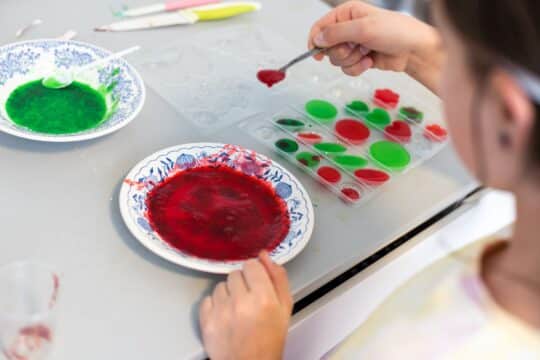If you constantly flip through project after project and everything starts to feel the same, whether it’s a diorama, slideshow, tri-fold board, or even a digital presentation, when it lacks creativity, it becomes forgettable fast. When projects feel like they are merely checking off boxes instead of sparking curiosity, students miss out on meaningful learning.
But the good news? You can help your students turn things around. With the right structure, a little inspiration, and a lot of choice, your students can start producing projects that feel fresh, exciting, and worth celebrating. Here’s how to guide them in that direction.
Let Students Have a Voice and a Choice
One of the quickest ways to see a difference in the quality of your students’ projects is by giving them ownership. When kids feel like they get to do something instead of having to do it, their energy shifts, and they tend to care more.
Start by offering options. Maybe it’s choosing the topic. Maybe it’s choosing how to present it. You can even go full menu-style and let them pick from a range of project formats: podcast, blog post, short film, infographic, skit—you name it. The point is, that when students feel like their ideas and preferences matter, they naturally engage more deeply.
If you’re not sure where to start, tap into their interests. Take a few minutes to ask about what lights them up outside of school. Maybe they’re obsessed with video games, animals, or baking. Help them channel those interests into their projects.
You can also weave in Howard Gardner’s theory of multiple intelligences to figure out how your students best express themselves; some shine when they write, others when they build, act, or code. Knowing how they learn helps you help them play to their strengths.
And while it’s important to let them lead, your role still matters. Be their soundboard, their cheerleader, and the person who helps them push their thinking a little further. Students thrive when they feel supported but not steered.
Promote Collaboration Through Group Work
When it comes to helping students create stronger projects, sometimes more really is better. Bringing together different voices and perspectives can take a basic idea and turn it into something much more meaningful.
Encourage your students to work in groups and take on roles that complement their strengths, but instead of assigning totally separate tasks, focus on roles that require real teamwork. The goal is collaboration, not division. Let them bounce ideas off one another, problem-solve as a team, and lean into what each person does best. That’s where creativity really starts to shine.
Keep an eye on group dynamics. Some students may need help learning how to listen, compromise, or take initiative. Build in regular check-ins where students reflect on how the group is working, not just on what they’re creating. This helps foster skills that go way beyond the project itself—skills like communication, empathy, and teamwork.
Cross Classrooms (and Even Borders!)
Sometimes, the best ideas come when students get to step outside of their usual environment. If you want to inject some new energy into a project, consider partnering up with another class. It could be another teacher on your team, a specialist like an art or music teacher, or even a class in a different grade.
Want to take it even further? Use tools like Zoom, Google Meet, or Flip to connect with students from another school, city, or even country. Collaborative projects with students outside their own bubble challenge kids to think globally, communicate clearly and consider other perspectives. That’s the kind of learning that sticks.
Plus, having an outside audience can be a powerful motivator. When students know that people beyond their classroom walls will see their work, they often try harder and think more creatively.
Tie Projects to the Real World
Relevance is transformative. When students recognize how their projects relate to something greater than school, they are more likely to engage and put forth their best effort.
Look around your community. What issues could your students explore through their projects? Perhaps there is a local park that needs cleaning or a shelter that could benefit from more support. Maybe traffic safety is a concern in your town, or there is a lack of recycling bins at school. Turn these real-world problems into project prompts.
When students understand their work has the potential to create positive change, they are more likely to invest time, thought, and creativity into what they produce.
Rethink the Way Projects Are Shared
Sometimes the problem isn’t the project itself, it’s the way it’s presented. If every student is standing in front of the class reading off an index card, it’s no wonder the energy falls flat. Instead, encourage students to find unique ways to share their work.
That could mean turning a research project into a short documentary, a podcast episode, a comic strip, or even a mini-exhibit where classmates walk around and interact with the projects.
Tech tools open up even more possibilities. iMovie, Canva, Book Creator, Google Slides with voiceovers, green screen apps—there are so many options to help students elevate their presentations and make them feel professional and polished.
Also, consider hosting a “Project Showcase” day where students invite families or community members to see their work. When there’s a real audience, students tend to up their game.
The most meaningful student projects are the ones that come from the heart. These are the projects students are truly excited to create, that tap into their unique strengths and align with how they learn best.
The teacher’s role shifts from leading every step to guiding from the sidelines, offering direction and support when needed, but ultimately giving students the space to take ownership.
When kids have the freedom to make creative choices and present their work in a way that feels true to them, the final result is almost always more thoughtful, more engaging, and more authentic.
Educators never stop learning; check out our available graduate degree programs to hone your skills and promote lifelong learning and academic excellence.




